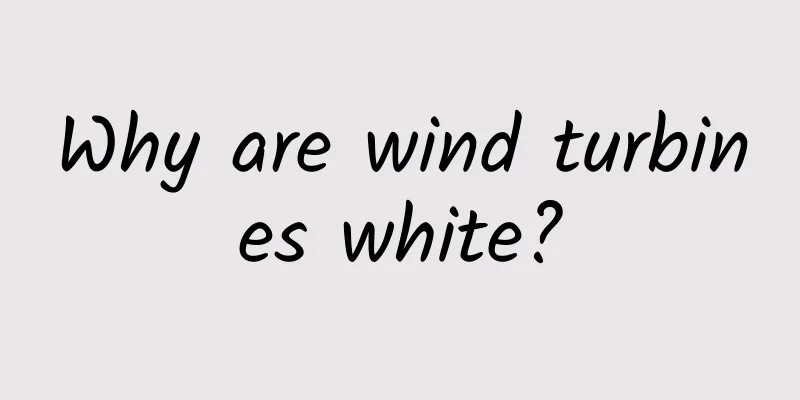Why are wind turbines white?

|
Author: Cheng Mingchen The article comes from the Science Academy official account (ID: kexuedayuan) —— I don't know if you have noticed that white aesthetics seem to be deeply rooted in people's hearts, from airplanes, cars, and Harmony Express to keyboards, mobile phones, and notebooks. For product design manufacturers, in addition to relying on appearance, the price of white paint is much lower than that of colored paint, and the overall cost can be minimized. As for why windmills are always white and cannot be red, orange, yellow, green, blue, or purple, there is a deeper reason~ The all-white wind turbine (Source: VEER) The Secret of White Wind Turbines White light is a mixture of all visible light in the spectrum and is generally considered "colorless" and has almost no presence in our field of vision. This monotonous neutral color is not aggressive and can "coexist harmoniously" with the surrounding environment. White wind turbines rarely make people around them feel abrupt. Painting the wind turbines in the color of the surrounding environment can help them blend into the local environment to the greatest extent. According to the local topography, the wind turbines are available in desert yellow, grassland green, ocean blue and other versions. Wouldn't it be possible to "blend in" with the environment? However, the surface environment is not static. In winter, autumn, spring, summer, day and night, sunny, rainy and snowy days, the surrounding environment will present completely different colors, and the versatile white is undoubtedly the safest choice. Wind turbine (Source: VEER) White is highly compatible with the natural environment, and on the other hand, it also highlights the presence of wind turbines. Except for snow, white surfaces are rarely formed in nature. It is easier for flight personnel in the air to see the towering white wind turbines on the ground and avoid these obstacles in advance. In order to make the wind turbine more conspicuous, the tip of the blade is often painted with red strips (beacon strips), and the cabin will also flash red beacon lights at night. According to German standards, when the wind turbine is within 5 kilometers of the airport, the tip of the blade needs to be marked with a beacon strip, and outside the 5-kilometer range, two beacon strips need to be marked. Most countries do not have standards for beacon strips. In domestic wind farms, you can see white blades, but more are blades sprayed with one, two or even three beacons. In addition to red, there are also orange, blue and black colors. Wind turbines with red labels (Image source: VEER) The design service life of wind turbines is 20-25 years, and they work in harsh natural environments. In addition to "drinking northwest wind" every day, they also have to "sunbathe" for a long time. White is not easy to absorb ultraviolet radiation in sunlight, which helps to alleviate the heat dissipation problem of electrical equipment such as generators and converters inside the unit, and at the same time reduces the risk of drying of lubricating oil and grease and generating bubbles. The white appearance helps operation and maintenance personnel to observe the oil stains on the surface and deal with them in time. In addition, the lower price of white paint will also reduce the manufacturing and operation and maintenance costs of the unit. Purple wind turbines? Not only are they cool, they also repel insects! White wind turbines are both beautiful and economical, but they are not perfect. Since white tends to attract insects, insects moving around the wind turbine will be caught in the strong airflow generated by the rapidly rotating blades. Their bodies will adhere to the leading edge of the blades in large quantities, which will greatly affect the aerodynamic performance of the wind turbine and reduce the power generation performance. In addition, insects will attract the attention of predators such as small and medium-sized birds and bats. "The mantis stalks the cicada, unaware of the oriole behind", and higher-level predators such as raptors such as hawks and falcons will also choose to hover over the wind turbine. Therefore, the rotating blades are a potential danger to the surrounding birds, and the impact of the blades will also pose a hidden danger to the structural reliability of the blades themselves. Early bird protection organizations strongly opposed the development and construction of wind farms. When they realized that thermal power generation would cause more serious harm to birds, they gradually accepted wind power generation. However, they strongly recommended using purple paint to spray wind turbines because purple would repel insects and thus protect the safety of birds to the greatest extent. They claimed that this was the best color for wind turbines. Actual surveys show that insects do have a certain tendency to avoid certain colors, and they have a special preference for yellow, so yellow adhesive tape is used in farmland to eliminate insects. From this perspective, wind turbines should avoid using yellow, and currently only the bottom foundations of some offshore wind turbines are yellow. Yellow insect-sticking paper sold on Amazon (Source: Amazon) Although insects generally avoid purple, purple will not be the color of choice for most wind turbines in the future. The noise, airflow, heat and other factors generated by wind turbines are potential reasons for insects to approach wind turbines. Although some purple wind turbines have a certain insect repellent effect, it is not obvious. It will take a long time to discover the truth about wind turbines attracting insects. Before that, purple wind turbines will not be built and installed on a large scale. Purple wind turbine (Photo: mywindpowersystem.com, Patrick Finnegan) Black fans allow birds to "see" obstacles In 2015, the U.S. Fish and Wildlife Conservation Organization estimated that about 300,000 birds had been killed by wind turbines across the United States. This may have become a perfect excuse to resist wind power. Trump, the "King of Understanding", jokingly called wind turbines "bird graveyards". After taking office, he completely abolished a series of clean energy plans formulated by the previous president. As early as 2003, W. Hodos, a scholar at the University of Maryland, discovered the phenomenon of "motion smear" or "motion blur" in birds in the laboratory. Using optical instruments for analysis, it was found that when birds gradually approached the rotating blades, the imaging speed of the blades on their retinas would increase accordingly. When the imaging speed reached the upper limit, their retinal images became transparent and blurred. These distorted images were transmitted to their brains, and the birds would default this area to a safe area and continue flying, which greatly increased their probability of hitting wind turbines. A wind farm might look something like this from the bird's perspective (Image source: discoverwindenergy.com) Since it is not easy for birds to observe rotating wind turbines when flying, would it be helpful to give them more visual cues? For example, painting the blades in different colors and patterns. In June 2020, researchers from the Norwegian Institute for Nature Research and the Ansø Lake Bird Observatory published a shocking discovery in the journal Ecology and Evolution. They conducted a test at a wind farm in the Smøla Archipelago in Norway. When one of the three wind turbine blades was painted black, the number of bird deaths dropped by 70%. A wind turbine with blades painted black (Source: arstechnica.com) The second phase of the Smøla wind farm has a total of 68 wind turbines with a blade length of 40 meters. Between 2006 and 2016, investigators conducted 9,557 regular inspections with trained dogs and found 464 bird carcasses. In order to conduct a pre- and post-treatment control experiment, four wind turbines were selected as the experimental group and the control group. Neither group of wind turbines was treated between 2006 and 2013. The four experimental wind turbines killed 11 birds, including six white-tailed eagles (Haliaeetus albicilla). Five willow grouse (Lagopus lagopus) were also killed, but they were not killed by the spinning blades but by hitting the wind turbine towers. The four control wind turbines killed seven birds during the same time period. The two groups of wind turbines are located in close proximity, so the significant difference may be due to some other, as yet unknown, factor. In 2013, one blade on each of the four test turbines was painted black. Over the next three years, six bird carcasses were found. In contrast, the four control turbines killed 18 birds. In other words, painting one blade black reduced annual bird mortality by nearly 70%. In fact, from the perspective of the spectrum, some animals have cone cells in their retinas that produce color vision, and the visual pigments in the cells can absorb electromagnetic waves of different wavelengths. The most sensitive spectral bands of the color cone cells in human eyes are red light, blue light, and green light, while birds have four types of cone cells that are sensitive to red light, blue light, green light, and ultraviolet light. The sensitivity of cones in humans and birds to light (Image source: Palaeontologia Electronica) Think about it, if two or even three blades are painted black, will the mortality rate drop further? Before further exploration, the repeatability of this experiment deserves to be confirmed again. The seemingly ideal results may be caused by accidental factors. Therefore, before the black blades are widely used, it is still necessary to conduct long-term investigations and accumulate data in multiple wind farms to draw more accurate and universal conclusions. In addition to generating electricity, wind turbines can also be works of art All white wind turbines are a bit monotonous, so in order to make wind turbines better carry local customs and create local wind farms, in some places, the towers and blades of wind turbines are spray-painted with patterns and patterns with local cultural characteristics, turning them into works of art. For example, the folk show in Guangxi: Niutouling Wind Farm in Tiandeng County, Chongzuo City, Guangxi (Photo source: Zuojiang Daily) Henan's yellow-bottomed cartoon: Tangyin Wind Farm in Henan (Image source: Wikipedia) References: [1] Roel May, Torgeir Nygard, Ulla Falkdalen, et al. Paint it black: Efficacy of increased wind turbine rotor blade visibility to reduce avian fatalities. Ecology and Evolution. 2020;00:1–9. [2] Hodos, W. Minimization of Motion Smear: Reducing Avian Collision with Wind Turbines; Period of Performance: July 12, 1999 -- August 31, 2002. United States. doi:10.2172/15004460. [3] https://discoverwindenergy.com/the-colors-of-the-wind-turbines-why-are-wind-turbines-white/ [4] https://arstechnica.com/science/2020/08/black-paint-on-wind-turbines-helps-prevent-bird-massacres/ [5] https://www.mywindpowersystem.com/2013/05/14/why-are-wind-turbines-white/ [6] Rowe MP. INFERRING THE RETINAL ANATOMY AND VISUAL CAPACITIES OF EXTINCT VERTEBRATES[J]. Palaeontologia Electronica, 2000, 3(1). |
>>: The cold winter is coming, what is the best way to keep warm in winter?
Recommend
The Top 1 Chinese University is controversial, but the Top 1 Chinese University Food must be this!
The Top 1 Chinese University is controversial, bu...
How to do data analysis on WeChat Official Account? Share 6 key points!
In fact, the meaning behind the data is logic and...
360 information flow advertising operation manual!
Compared with Toutiao ads, Baidu information flow...
Apple submits training plan for operators for new autonomous driving progress
According to Reuters, in a document submitted to ...
Looks like a little "towboy", but it turns out to be a Devonian coral
When the weather is hot, I can't help missing...
An anonymous source revealed how ASO Himalaya was created
An anonymous source revealed how ASO Himalaya was...
Today is Laba Festival丨The Laba garlic turns green, is it really spoiled?
Today is the eighth day of the twelfth lunar mont...
What are the requirements for a bidding promotion creative?
There should be at least 1-2 wildcards in the tit...
4,870 varieties, why does Peru collect so many potatoes?
In two inconspicuous small buildings in the south...
Is there a mysterious element in the periodic table that is unknown to the public?
Produced by: Science Popularization China Author:...
22 truths about private domain traffic
The term private domain traffic has been popular ...
Engineering and cost management from the perspective of the project manager, a compulsory course for improving project manager's ability
Engineering and cost management from the perspect...
Why is this black hole so different? It may provide important clues to solve astronomical mysteries
The hunt is on for the second-closest supermassiv...
User growth: How to build an analysis system?
In the world of the Internet , everything is for ...
Barnacles are never seen on killer whales. Do barnacles bully the weak and fear the strong?
Earlier, people were not particularly familiar wi...









